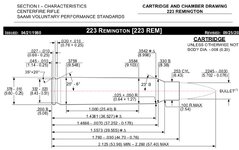I’m going to ask a dumb question, I’m a noob to reloading, forgive me.
I’ve searched and got a lot of mixed results, hence the post.
I have piles of once fired brass but they have been shot out of multiple different rifles. I had a Seekins PH2, than a Tikka Roughtech and now a Seekins PH3 (yes, I have a problem haha).
Are there any issues reloading them into my current rifle? Obviously every chamber is slightly different.
I’ve been wanting to reload for years and years, but didn’t have the time, or could justify it by the amount I would shoot annually. As I dive deeper into longer range stuff, the more I want out of my ammo, particularly speed variance.
I’ve searched and got a lot of mixed results, hence the post.
I have piles of once fired brass but they have been shot out of multiple different rifles. I had a Seekins PH2, than a Tikka Roughtech and now a Seekins PH3 (yes, I have a problem haha).
Are there any issues reloading them into my current rifle? Obviously every chamber is slightly different.
I’ve been wanting to reload for years and years, but didn’t have the time, or could justify it by the amount I would shoot annually. As I dive deeper into longer range stuff, the more I want out of my ammo, particularly speed variance.

